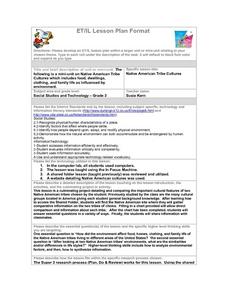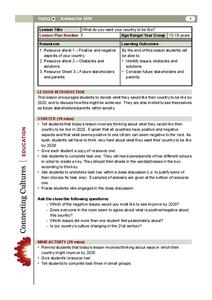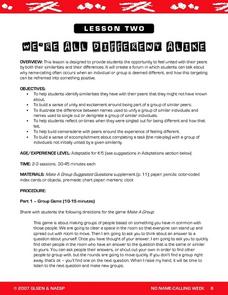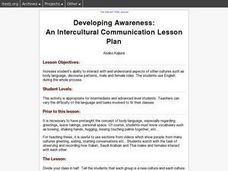Curated OER
Compare the Presidents
How are Nicolas Sarkozy and Barack Obama similar? How are they different? Look at two visual representations of them; what kind of first impression does they give you? After comparing the presidents, learners complete a proverb matching...
Curated OER
Japan Communication
The Japanese communicate in very different ways than people in the US. Using three essential questions as a guide, learners look at different scenarios (included) and compare customs seen here and there. All the materials you need are...
Japan Society
Popular Culture and Japan’s Gross National Cool
From Manga to Godzilla and Pokemon, Japanese pop culture has been taking the globe by storm. This phenomenon is called "soft power." Learners will examine the differences between hard and soft power, as well as learn the historical...
Maryland Department of Education
The Concept of Diversity in World Literature Lesson 5: The Tragic Hero
Should identifying a tragic hero be based on a universal definition or a definition based on the morals and values of a specific culture? As part of a study of Things Fall Apart, class members read Sylvia Plath's "Colossus" and then...
Curated OER
Culture Sharing:
Students share their unique cultures with others in the class and identify with different cultures from their own. Students use their English speaking skills to work with the other students from the same or nearby country. Students...
Curated OER
Native American Tribe Cultures
Third graders choose two Native American tribes to compare and contrast using an assigned website. They complete a chart that shows how the tribes are the same and different. Using information gathered on their charts, they answer...
Curated OER
Shizuko’s Daughter: Before, During, After Lesson Plan
Shizuko's Daughter by Kyoko Mori presents a vivid picture of Japanese culture and history. As kids read through the third chapter, they find novel-specific vocabulary to enhance their understanding and use context clues to...
Curated OER
Food and Culture: Exploring the Flavors of Your Community
Students brainstorm the types of food they eat at home, discussing and comparing with the class. Students brainstorm and make a chart of questions that came out of the activity and their discussions. Students interview someone who...
Curated OER
Shizuko’s Daughter: K-W-L
What would your class like to learn about Japanese culture? Prepare them for a novel unit about Kyoko Mori's Shizuko's Daughter with a KWL chart. After listing what they already know about Japanese culture, they write questions...
University of the Desert
What Do You Want Your Country to be Like?
How would you like your country to be by 2020? What issues do you feel are most important, and how do those compare with your peers? Learners tackle questions regarding the evolving national and global culture of the twenty-first century...
Folger Shakespeare Library
Essential Everyday Bravery
Shakespeare's plays may be old, but they still have relevant lessons for today's world! A collection of lesson plans uses examples from The Merchant of Venice and District Merchants to teach about bravery. In addition to learning...
Curated OER
Shall We Dance?
This four to five day mini dance unit has many components. Discussion on what makes a good dance partner, research on famous dancing pairs, as well as learning a choreographed piece in class. The class learns a short dance sequence and...
Curated OER
Around-The-World Storytellers
Students examine what daily life is like for children living in other countries around the world. They read different books in the "Maya's World" series of books by Maya Angelou, write and illustrate an original story about a child in...
PBS
Venn Diagram: My Partner and I Are Different
Celebrate your class's diversity with this Venn diagram template. A perfect resource for building a classroom community at the beginning of the school year, pupils are able to learn about their peers while discovering what...
Curated OER
A Jaded Culture
Students explore symbolic gems and metals of different cultures. They demonstrate their understanding of the use of such symbols in our own culture. They read and discuss the Times article, It's jade Time At The Galleries And The Fair.
Curated OER
The Art and Culture of Spain
Students can explore the history, culture and art of Spain with motivating activities.
Curated OER
History and Culture of Turkey
An exploration of the history and culture of Turkey can provide students with a greater understanding and appreciation of this region.
Curated OER
History and Culture of Russia
The history and culture of Russia is one of the most complex in Europe, and can provide interesting learning opportunities.
Curated OER
Religious and Cultural Festivals of the World
Here are some interesting activities teachers can do with students to teach them about the religious and cultural festivals of the world.
Curated OER
We're all different alike?
Students identify similarities and differences that they have with their peers. They explore why name-calling often occurs when an individual or group is deemed different, and how this targeting can be reframed into something positive
Curated OER
Where Is Japan? How Are We Alike And Different?
First graders use literature, maps, and globes to explain how physical environments in various parts of the world are similar to and different from one's own, and that certain areas have common characteristics and can be called regions.
Roy Rosenzweig Center for History and New Media
Differences Among Colonial Regions
Classes look at and analyze primary source images to explore the differences between the colonial regions during the Revolutionary era. They break into groups to tackle each region and then present their findings to the class. A final...
Curated OER
Japanese Culture
Ninth graders examine the differences in the way genders have been treated in the same society over the course of a nation's history. For this World History lesson, 9th graders study the factors that have caused changes in...
Curated OER
Developing Awareness: An Intercultural Communication Lesson Plan
Students, divided into two groups, are put into a new culture, where they must create their own body language for greetings, etc. They learn aspects of other cultures such as body language, discourse patterns, male and female roles.























